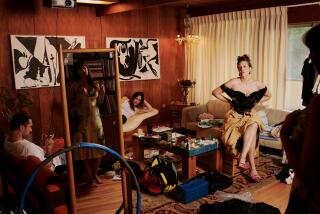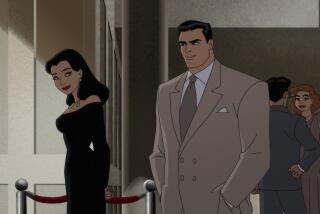His derring do-over
- Share via
When “THE Dark Knight” director Christopher Nolan and Oscar-winning costume designer Lindy Hemming considered how they would retool Christian Bale’s Batman armor for the new movie, one question leaped to mind immediately: “Why, in 2008, would a superhero put on a rubber suit?” Hemming asks. “Why would he wear something that made him less active and unbelievably, unpleasantly hot? He wouldn’t. He’d use all the technology available to be as comfortable as possible.”
So when audiences get a look at the new, heavily segmented Batsuit with its Kevlar pecs and abs and exposed titanium-mesh under layer, they should know that this was no George Clooney Batnipple exercise in impishly messing with tradition. Rather, the “Dark Knight” crew was adhering to the creative mandate that Nolan first set on “Batman Begins”: Ground the proceedings as much as possible in real-world believability. As costume effects supervisor Graham Churchyard pointedly puts it, “You’re supposed to be scuba diving in a neoprene body suit, not kickboxing.”
The filmmakers admit they had originally discussed many of the same design ideas for “Begins.” At the time, though, they found themselves steered back toward the established molded-latex look by budget considerations, as well as concerns that they were already redefining the character pretty radically. “In the first movie, we spent the money on the car, the Tumbler,” Nolan says. “But for the second film, I was intent on spending on the costume.” A good six months in the making, the new design was replicated for 25 suits, at a cost of hundreds of thousands of dollars.
“This time we made the suit that Chris really wanted,” says Churchyard, who oversaw a team of 40 craftsmen, from sculptors to computerized milling machine operators, in the production’s London fabrication workshop. “In ‘Begins,’ there’s that pre-suit that Bruce Wayne gets from [Morgan Freeman’s] Lucius Fox and sprays black. The script tells us it contains Kevlar weave and various layers. But now, it actually does. We’ve taken the pre-suit to the next stage, really.”
While much of the costume development on the last go-round involved research into cutting-edge military and survival wear, the focus on “Dark Knight” was on motocross gear and extreme-sports apparel. (Hemming says it’s purely coincidental that Batman races around on a motorcycle in the movie -- although the advent of this “Batpod” did lead directly to a Batpack, modeled on a bat’s folded wings, for getting that flowing cape the heck out of the way.) Nolan liked the last Batsuit’s overall silhouette, the shoulder line and the look of the cowl, but he wanted something that offered protection with greater freedom of movement. “Christian is so active, and does so many movements that previous Batmen weren’t able to do,” says Hemming, “it was important to us that he be able to do them even more.”
At 30 pounds, the redesigned armor actually weighed slightly more than the “Begins” model, but its 110 component parts better distributed the load and let in a bit of air. “I hate to describe it this way, but the suit’s like a big sneaker,” Churchyard says. “It has armored elements with carbon fiber running through them, but also semi-rigid areas for flexibility, and mesh panels that allow it to breathe. You end up with these kinds of crumple zones that allow you to bend, to crunch.”
Bale half-joked on the last movie that it wasn’t difficult for him to get into brooding character when wearing his costume was such a brutally constricting experience. One of the biggest problems was the cowl, which was anchored to the suit’s trunk only slightly less stiffly than it had been back in Michael Keaton’s caped-crusading days nearly two decades ago. “That ‘Begins’ image of Batman with his head forward and that big, muscular, panther neck was great as a poster,” says Churchyard. “But that’s kind of what was stopping him from moving.” So, after years of actors having to do “the Batmove,” turning their head and shoulders in the same motion, the design team finally figured out a way to section off the cowl. A series of rings seamlessly incorporated around the base allowed it to function as a piece separate from the rest of the costume.
‘I could turn my neck’
Summing UP the differences between the old Batsuit and this season’s model, Bale sounds like he was liberated from something akin to that Bhutanese prison at the opening of “Begins.” “For one thing, I could turn my neck,” he says. “For another, I didn’t get awful headaches just from wearing it. It was an entirely different experience. It was fewer pieces and it didn’t require a team of people to get me in and out of it.”
Nolan’s satisfaction with the outfit is reflected in how visible it is in the movie. In the previous installment, the aesthetic approach was to portray Batman as a shadowy avenger -- minimally lit, always seen at night, and rendered as matte as possible to heighten the effect. Here, he steps into the light. Warner Bros.’ publicity images have favored keeping the dark in “Dark Knight,” but a recent, brightly photographed “Got Milk?” ad featuring Bale in costume showed every little detail -- and generated much discussion among fans. “A big thing we were after was giving the suit more texture,” Hemming says. “Visually, you’re getting much more information as to how it works.”
“We wanted something that was real, something functional,” Nolan says. “In the first film, it was designed to look real, but the mechanics and surfaces of it were not as they appeared. In this film, the suit is as it appears -- and it works.
--”
Times staff writer Geoff Boucher contributed to this report.
More to Read
Only good movies
Get the Indie Focus newsletter, Mark Olsen's weekly guide to the world of cinema.
You may occasionally receive promotional content from the Los Angeles Times.










